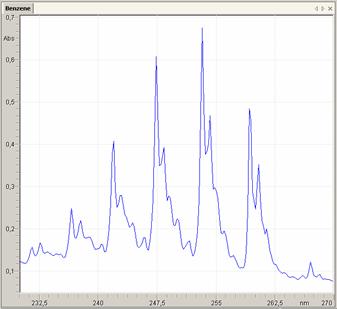2D Data
In the past as well as today mostly 2D analytical data are recorded to visualize the behaviour of two independent parameters, although in times of modern computer technology, multi-dimensional data acquisition is also possible and will be applied in many cases.
In the software we distinguish discrete data and equidistant data objects, which sometimes leads to a limitation of applicable mathematical functions.
2D Data Example
A typical example for a 2D data object is a UV/VIS spectrum, where the absorption of a suitable material is measured within the wavelength range of interest. The resulting spectrum is a 2D data object with the absorption on the y-axis and the respective wavelength on the x-axis. The UV/VIS spectrum of benzene in the range from 230 to 270 nm looks as follows:
